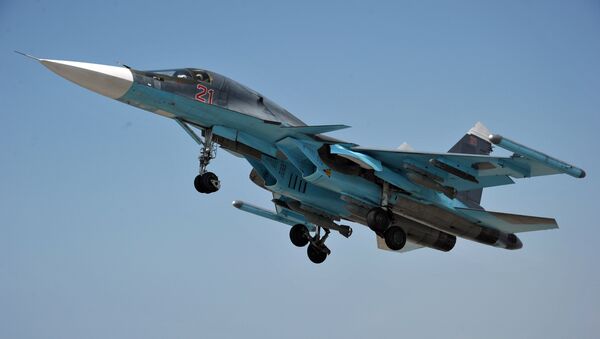Versatility
The Su-34 was constructed with the intent to carry almost any type of modern Russian armament — from unguided bombs to satellite guided missiles. In Syria, hundreds of terrorist fighters and dozens of their leaders have been killed in precision strikes conducted using Su-34 aircraft. Its ability to lock on to multiple moving targets doomed many of their armored columns and oil transports.
READ MORE: Russia's Su-34, Su-35 Jets Hit Militants in Syria, Prevent Them From Regrouping
But the Su-34 is capable not only of being equipped with air-to-surface missiles, but also air-to-air. Despite being focused on delivering strikes against enemy ground targets, the Russian jet is capable of defending itself from attacks by other jets. Its weapons and backwards-directed radar allows Su-34 to fend off practically any enemy pursuing it.
'Invisibility Cloak'
Right now the Su-34 jet is equipped with "Hibin" cisterns that disrupt the operation of enemy radars, rendering it practically "invisible." But the Russian military is planning to replace it with the newer "Tarantul," capable of hiding several jets in a strike group from enemy radars at the same time, like an "invisibility cloak."
Pilots Work Side-by-Side
Another unusual feature of the jet is the Su-34's cabin — the pilots don't sit one in front of the other, but beside each other, allowing them to communicate in any situation without using radio. Moreover, it removes the necessity for the second control panel, as most of the controlling can be done jointly.
Such a design allows for direct communication between the co-pilots in dire situations and a special pressurization system makes the air in the cabin breathable up to an altitude of 10km, removing the need for oxygen masks below that height. The cockpit also has enough space for pilots to stand up and walk around or even to have some tea during long range flights.
READ MORE: WATCH Russian Su-34 Fighter Jets Practicing Precise Bombing
While the Su-34 is a new addition to the Russian Armed Forces, entering service in 2014, it is already battle-tested as a result of operations in Syria, with its designers detecting and fixing many of the original flaws that became apparent over the course of the operations of the Russian Air Force. Currently, there are just a few Su-34 jets operational, but their number is expected to reach 100 by 2020, as factories building the planes increase their rate of production, along with increased funding.



